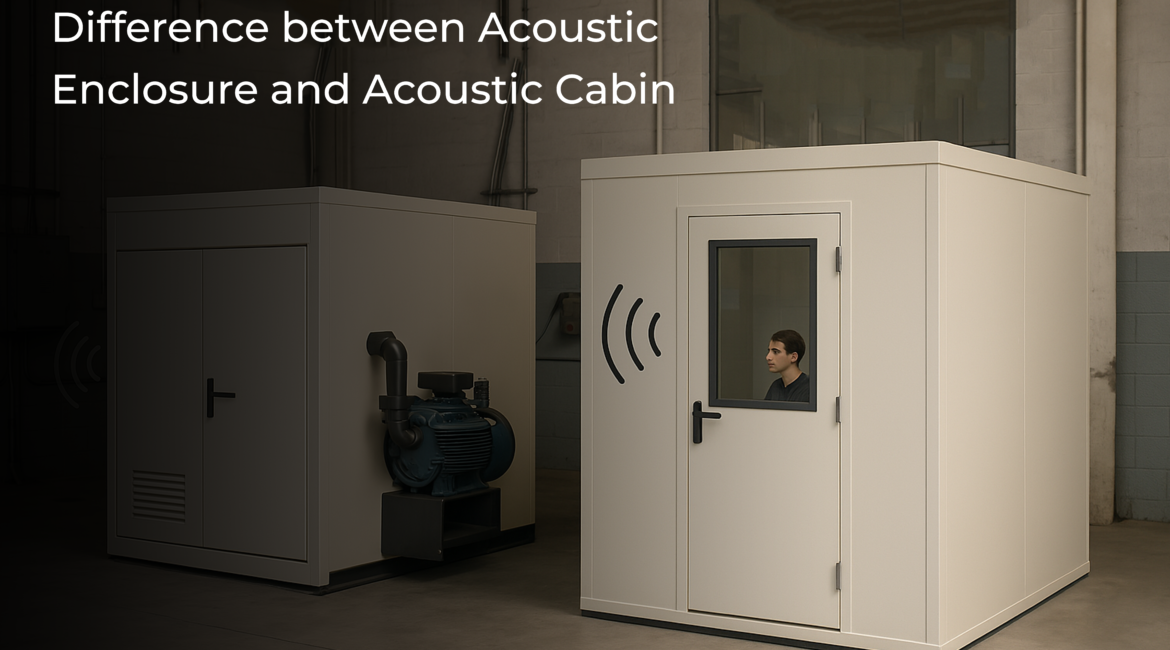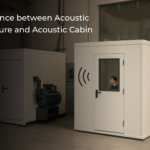Industrial noise pollution is a serious problem worldwide. The primary sources of industrial noise pollution are heavy machinery, industrial processes, and vehicles. It can negatively impact human health, ecosystems, and communities. Besides causing health issues like hearing loss and stress, it can interfere with your communication and concentration and reduce the quality of your life. Hence, you need to address this problem by installing acoustic enclosures and cabins that will help protect your health from the effects of noise pollution and improve your quality of life.
If you are hearing about Acoustic Enclosures and Cabins for the first time, you might think they are the same thing, which is not true. While both are designed to reduce noise, there are some stark differences in the design that define their applications. Here is a detailed breakdown of Acoustic Enclosures and Cabins that will help you choose the right soundproofing equipment for your facility.
Acoustic Enclosures
- Purpose: Acoustic enclosures are designed to reduce noise levels by containing the sound generated by machinery or equipment thereby creating quieter and safer work environments.
- Design: The design of an acoustic enclosure involves creating structures around the equipment or machinery that effectively absorb sound waves and prevent their transmission in the work environment. The structure of an acoustic enclosure includes a dense solid exterior made from galvanized steel or other material that prevents sound from escaping. The interior of the structure is covered by sound-absorbing materials like acoustic foam, fiberglass, or mineral wool.
The acoustic enclosure is designed in such a way that there is no direct contact between the acoustic structure and machinery to maintain optimum performance. The enclosure structure is built robust and adheres to relevant standards like the Euro code for structural integrity.
- Focus: the main focus of the acoustic enclosure is to isolate noise from environment and preventing it from escaping or entering the structure.
- Key Components and Accessibility: the acoustic enclosures may have windows, design doors, and access panels for easy access to machinery for maintenance tasks. They also have windows, and louvers as heavy machinery also needs ventilation to regulate and maintain temperatures. Some acoustic enclosures may also have integrated ventilation systems to maintain certain temperatures and prevent noise transmission. Depending on safety requirements, acoustic enclosures may also incorporate fire suppression systems and emergency lighting.
- Applications: Acoustic enclosures are generally used for compressors, generators, and other noisy equipment.
Acoustic Cabins
- Purpose: Acoustic cabins are designed to reduce noise pollution and create a quiet environment allowing the people inside to better focus on the work. Unlike Acoustic enclosures that contain machinery sound and prevent it from entering the environment, Acoustic cabins are enclosed spaces/ soundproof spaces (preventing outside noise from entering inside) thereby protecting the inhabitants from unwanted noise.
- Design: Acoustic cabins have a simple design and the first criterion is comfort. They are designed in such a way that the user can sit inside the enclosed space comfortably for long hours. The structural elements and sound-absorbing materials used in construction minimize sound transmission and enhance sound quality. The design of the acoustic cabins depends on several factors including the intended use of space like relaxation, video conferencing, phone calls, meetings, and individual work.
The size of the cabin depends on how many people you want to accommodate. The sound-absorbing material (type and thickness) used in the construction depends on the desired level of sound insulation needed and reverberation control. When designing acoustic cabins, engineers consider the need for proper ventilation, comfortable seating, and sufficient lighting. You also need to assess the available space to construct acoustic cabins before designing one and assess any limitations and dimensions for access beforehand.
- Focus: The main focus of building an acoustic cabin is to protect human beings from environmental noise. It allows users to isolate themselves from noise and focus on work for improved productivity. It also helps in increased employee well-being and job satisfaction.
- Key components and accessibility: the key components of acoustic cabins include soundproof doors and walls often made of sound-absorbing materials like stone wool, mineral wool, or fiberglass. The key components are generally covered with a single dense layer of sound-absorbing material or multiple layers. The joints are carefully sealed to prevent sound leakage. Acoustic cabins have integrated ventilation systems to ensure fresh air circulation within designated areas without compromising on sound isolation. Some acoustic cabins like the ones used in recording studios also have bass traps installed that absorb low-frequency sounds that are problematic in enclosed spaces. Acoustic cabins used in recording studios also have sound diffusers installed that distribute sound energy evenly in the enclosed spaces and prevent sound from becoming concentrated in certain areas.
- Applications: Acoustic cabins are used in different settings. In industrial settings, they are generally used for control rooms and operator cabs for heavy machinery where they work to protect workers from noise-related health risks and improve communication. In corporate settings, acoustic cabins are used to create private spaces for phone calls, meetings, and focused work in shared office spaces. Other applications of Acoustic cabins include music studios and creating quieter spaces for research and testing.
Wrapping Up:
Thus you can see Acoustic Enclosures and Acoustic Cabins are different products. The differentiation given above will help you understand their design and applications thereby allowing you to choose a right soundproofing solution for your business.






